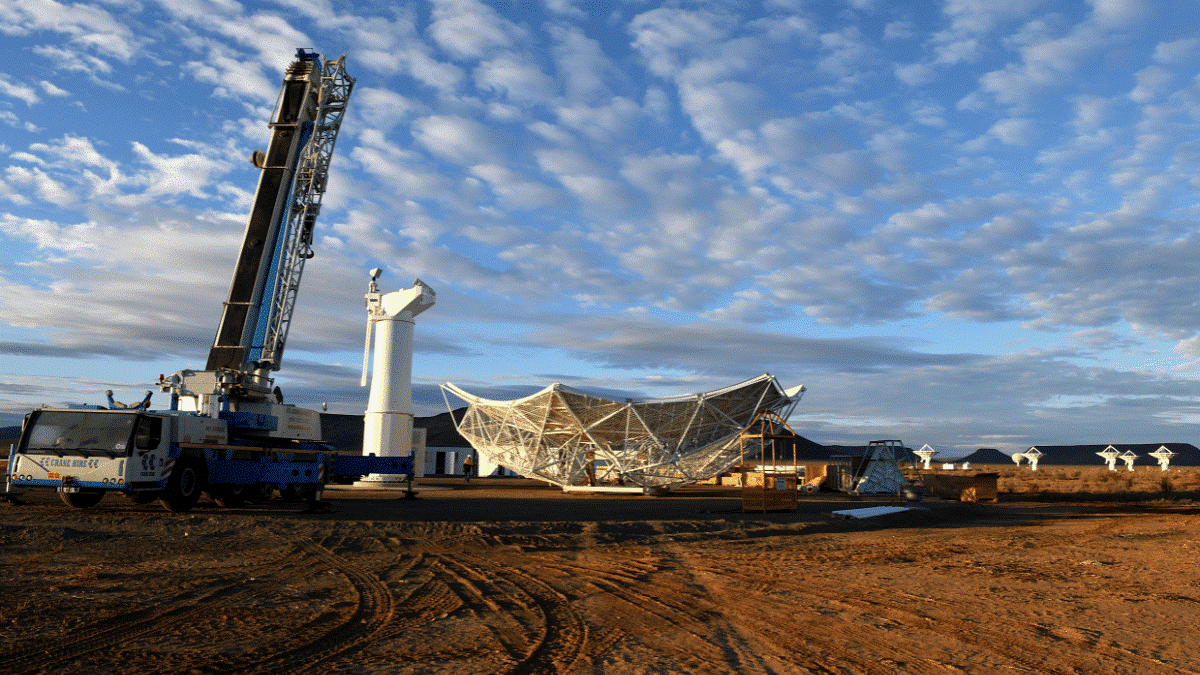Description

Disclaimer: Copyright infringement not intended.
Context
India will be providing Rs 1,250 crore to the multinational Square Kilometer Array (SKA) project, whose telescope arrays or groups of telescopes will be built in Australia and South Africa.
Details
- The Square Kilometre Array (SKA) is a groundbreaking intergovernmental radio telescope project planned to be constructed across two continents: Australia (for low-frequency observation) and South Africa (for mid-frequency observation).
- The central infrastructure and headquarters, known as the Square Kilometre Array Observatory (SKAO), are situated at the Jodrell Bank Observatory in the United Kingdom.
- The choice of the southern hemisphere for the SKA core locations aims to provide the clearest views of the Milky Way galaxy while minimizing radio interference.
Project Background
- Conception: Originated in the 1990s and further refined in the late 2010s.
- Goal: When completed in the 2020s, it's anticipated to cover an area of approximately one square kilometer, making it 50 times more sensitive than any existing radio instrument.
Structure and Operations
- Size and Sensitivity: With thousands of antennas spread over thousands of kilometers, the SKA aims to simulate a single powerful radio telescope using aperture synthesis.
- Observational Speed: Expected to conduct sky surveys over ten thousand times faster than current capabilities.
- International Consortium: Formed in 2019, the SKAO comprises multiple member countries responsible for constructing and operating the facility.
- Construction Phases: The project involves two construction phases - SKA1 (current) and a potential future expansion called SKA2. Construction occurs in two phases, with SKA1 commencing in December 2022 and expected to start operations by 2029.
Technical Aspects
- Frequency Range: SKA will operate across a wide frequency range from 50 MHz to 14 GHz.
- Array Design: Utilizes various types of antenna arrays, including phased array dipole stations (SKA-low), dish antennas (SKA-mid), and parabolic dishes for medium frequencies (SKA-survey).
Financial and Membership Information
- Costs: Estimated around €1.8 billion in 2014 with subsequent increases and delays, reported as worth A$3 billion as of December 2022.
- Membership: SKA is an international collaboration with 16 consortium members, including countries like Australia, South Africa, Canada, China, India, Japan, and others.
- Precursor Facilities: ASKAP, MeerKAT, Murchison Widefield Array (MWA), and HERA.
- Pathfinders: LOFAR, Allen Telescope Array, and other initiatives contributing to SKA-related technology and science.

India's Contribution:
- The Indian government has approved a monetary contribution of Rs 1,250 crore to the SKA project.
- Indian institutes and universities, including NCRA-TIFR, BITS Pilani, IISERs, and several others, are actively involved in SKA research.
Scientific Objectives
- General Relativity Tests: Using pulsars and black holes to test Einstein's theory of general relativity.
- Galaxy Surveys: Mapping a billion galaxies, studying galaxy formation, and observing cosmic structures.
- Epoch of Reionization: Observing the transition from the Dark Ages to First Light after the Big Bang.
- Cosmic Magnetism: Studying the origin and evolution of cosmic magnetic fields.
- Search for Extraterrestrial Life: Investigating habitable zones, prebiotic chemistry, and potential signals from extraterrestrial civilizations.
About telescopes
- Telescopes are optical instruments that gather and magnify distant light, allowing us to observe celestial objects such as stars, planets, galaxies, and nebulae.
Types of Telescopes:
- Refracting Telescopes: These use lenses to gather and focus light. They have a long tube with an objective lens at one end and an eyepiece at the other.
- Reflecting Telescopes: These employ mirrors to collect and focus light. They consist of a large primary mirror that reflects light to a secondary mirror and into an eyepiece or camera.
- Catadioptric Telescopes: These combine lenses and mirrors. Examples include Schmidt-Cassegrain and Maksutov-Cassegrain telescopes, which use both mirrors and lenses in a compact design.
- Radio Telescopes: These instruments detect radio waves emitted by celestial objects. They consist of large dish antennas to collect radio waves, similar to optical telescopes.
Optical Telescopes:
Visible Light Telescopes:
- Function: Studies light within the visible spectrum (400-700 nm).
- Examples: Hubble Space Telescope, James Webb Space Telescope.
- Significance: Observes stars, galaxies, nebulae, and planets in visible light, providing high-resolution images.
Infrared Telescopes:
- Function: Detects infrared light emitted by cooler or distant objects.
- Examples: Spitzer Space Telescope, James Webb Space Telescope.
- Significance: Observes cold stars, brown dwarfs, nebulae, and distant galaxies.
Non-Optical Telescopes:
Radio Telescopes:
- Function: Detects radio waves emitted by celestial objects.
- Examples: Square Kilometre Array (SKA), ARIES Telescope.
- Significance: Studies cosmic microwave background, pulsars, starburst galaxies, and more.
Microwave Telescopes:
- Function: Measures cosmic microwave background radiation.
- Examples: Cosmic Microwave Background Explorer (CMBE), Planck Telescope.
- Significance: Aids in understanding cosmological parameters and cosmic evolution.
X-ray Telescopes:
- Function: Observes high-energy X-rays emitted by celestial bodies.
- Examples: Chandra X-ray Observatory, XMM-Newton.
- Significance: Studies black holes, neutron stars, galaxy clusters emitting X-rays.
Ultraviolet Telescopes:
- Function: Observes ultraviolet radiation (10-320 nm) from stars, galaxies, etc.
- Examples: Hubble Space Telescope, ASTROSAT.
- Significance: Studies energetic phenomena, star formation, and emissions from stars.
Gamma-Ray Telescopes:
- Function: Detects high-energy gamma rays from sources like supernovae and black holes.
- Examples: Fermi Gamma-ray Space Telescope, HESS.
- Significance: Observes gamma-ray bursts, energetic cosmic phenomena.
Components of a Telescope:
- Objective Lens or Primary Mirror: This collects light and forms the primary image of the observed object.
- Eyepiece: It magnifies the primary image formed by the objective lens or mirror, allowing observation.
- Mount: Provides stability and enables the telescope to track celestial objects. Mounts can be alt-azimuth (up-down, left-right movement) or equatorial (aligned with the Earth's axis for tracking).
- Tube: The structure that houses the optical components, protecting them from external elements and stray light.
- Focuser: It allows for fine-tuning the focus of the telescope.
- Finder Scope: A smaller, secondary telescope mounted alongside the main one, aiding in locating celestial objects.
How Telescopes Work:
- Gathering Light: The primary function of a telescope is to collect and concentrate light from distant objects, increasing their apparent brightness.
- Magnification: Telescopes use lenses or mirrors in combination with eyepieces to magnify the images of celestial objects, making them appear larger.
- Resolving Power: This refers to a telescope's ability to distinguish fine details. Larger apertures (the diameter of the primary lens or mirror) generally result in better resolution.
Significance and Applications:
- Astronomy: Telescopes are fundamental tools for studying celestial objects, aiding in understanding the cosmos, observing celestial events, and discovering new celestial bodies.
- Education and Outreach: Telescopes play a crucial role in engaging and educating the public about astronomy and space science.
- Scientific Research: Telescopes support various scientific fields beyond astronomy, including atmospheric studies, Earth observation, and more.
- Technological Advancements: Advances in telescope technology drive innovations in optics, imaging, and data analysis, contributing to broader scientific advancements.
Top 10 telescopes on Earth:
- 500-Meter Aperture Spherical Telescope (FAST):
-
- Location: Guizhou, China
- Type: Radio
- Diameter: 1,640 feet (500 meters)
- Current Largest: Opened in 2020, the world's largest single-dish ground telescope.
- Extremely Large Telescope (ELT):
-
- Location: Atacama Desert, Chile
- Type: Optical-infrared
- Diameter: 128 feet (39.3 meters)
- Objective: Discover Earth-like planets and search for extraterrestrial life.
- Square Kilometre Array (SKA):
-
- Location: Australia and South Africa
- Type: Phased array, radio
- Scale: Enormous project with hundreds of telescopes; to be 100 times more sensitive than current telescopes.
- Thirty Meter Telescope (TMT):
-
- Location: Mauna Kea, Hawaii
- Type: Optical-infrared
- Diameter: 98 feet (30 meters)
- Under Construction: Collaborative project aiming to analyze black holes.
- Giant Magellan Telescope (GMT):
-
- Location: Atacama Desert, Chile
- Type: Optical
- Diameter: 80 feet (24.5 meters)
- Expected: Set to produce images 10 times clearer than Hubble upon completion in 2029.
- Atacama Large Millimeter Array (ALMA):
-
- Location: Atacama Desert, Chile
- Type: Radio
- Diameter:4 feet (12 meters)
- Feature: Consists of 66 radio telescopes; detected distant oxygen in space.
- South African Large Telescope (SALT):
-
- Location: Karoo, South Africa
- Type: Optical
- Diameter: 36 feet (11 meters)
- Noteworthy: Inspired by Hobby-Eberly; discovered the first white dwarf pulsar.
- Gran Telescopio Canarias (GTC):
-
- Location: La Palma, Spain
- Type: Optical-infrared
- Diameter:1 feet (10.4 meters)
- Significant Discovery: Identified the most densely populated galaxy cluster.
- Keck Telescopes:
-
- Location: Maunakea, Hawaii
- Type: Optical and Infrared
- Diameter:8 feet (10 meters)
- Capability: Surpasses Hubble in observing depth; most scientifically productive among land telescopes.
- Hobby-Eberly Telescope:
-
- Location: Texas, United States
- Type: Optical
- Diameter: 32 feet (10 meters)
- Unique Feature: Mirror tilted 55 degrees; rotating mechanism observes 70% of the sky.
- Significant Discovery: Detected light from a quasar dating back to when the Earth was much younger.

Other Notable Telescopes and Their Contributions:
- Hubble Space Telescope: Studied galaxies, black holes, dark energy, and made profound discoveries in cosmology and exoplanets.
- James Webb Space Telescope (JWST): Set to explore the formation of galaxies, stars, and planetary systems, observing in the infrared spectrum.
- Chandra X-ray Observatory: Explored high-energy phenomena such as black holes, neutron stars, and supernova remnants through X-ray observations.
- Spitzer Space Telescope: Investigated infrared emissions from distant galaxies, dust lanes, and exoplanets, contributing to our understanding of the cosmos.
- Fermi Gamma-ray Space Telescope: Explored gamma-ray bursts, dark matter, and high-energy cosmic sources through gamma-ray observations.
- ARIES Telescope: Designed to investigate star structures, magnetic fields, planets, and stars, contributing to astronomical discoveries.
- ASTROSAT: India's multi-wavelength space telescope studying high-energy processes in binary star systems, neutron stars, and galaxies.
- Thirty Meter Telescope (TMT): An upcoming large optical telescope aiming to provide sharper images for advanced astrophysical research.
- Liquid-Mirror Telescope (LMT): India's operational telescope for observing asteroids, supernovae, and astronomical objects.
|
PRACTICE QUESTION
Q. Which of the following telescopes operates using a technique that involves the detection of cosmic rays and their impact on the Earth's upper atmosphere to indirectly observe celestial objects?
A) Exoplanet Exploration Telescope
B) Neutrino Detection Telescope
C) Cherenkov Telescope Array
D) Gravitational Wave Observatory
Correct Answer: C)
|








